The best way to update your apartment- paste new wallpaper. In 1-2 days, your home can change dramatically: visually become larger or smaller, more secluded or more spacious. All this depends on the choice of wallpaper. You also need to consider the wallpaper material and the purpose of the room (living room, children's room, bathroom, etc.). So what wallpaper should you choose for your home in a particular case? Let's consider further.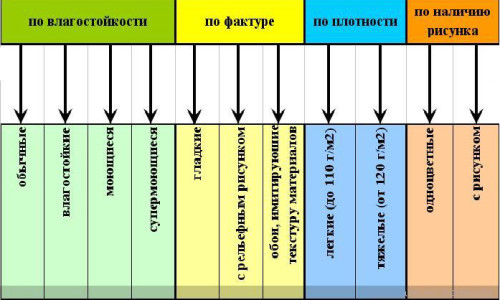 Classification of wallpaper.
Classification of wallpaper.
Types of wallpaper: material and features of pasting
Wallpapers have a wide classification by material.manufacturing. If earlier only paper and fabric were used as it, today with the development of new technologies the range of wallpapers has expanded. What types of wallpaper exist depending on the material of manufacture? Return to contents</a>Paper wallpaper:Features This option is a timeless classic. This type of wallpaper came to us from the East, where it is considered a traditional material. In the 18th century, paper wall coverings began to be actively used in Europe. Today, such wallpapers are the most inexpensive and easy way to decorate walls, which is why they have gained particular popularity. In addition, the paper is environmentally friendly (permeable to air), so it can be used in almost any room.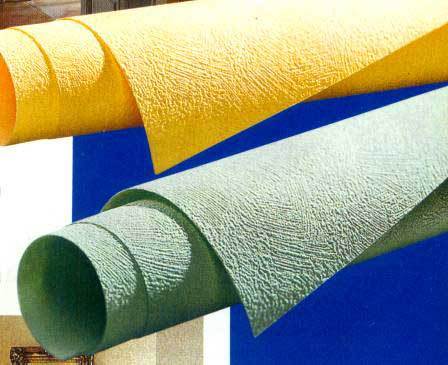 It is not recommended to glue paper wallpapers inrooms with high humidity. The main disadvantage of this material is its fragility. Firstly, such a coating cannot be used in rooms with high humidity. Secondly, it is prone to abrasion. When pasting, they show the following disadvantage - low strength. They are easy to tear. If they are crookedly glued, then they cannot be moved. They must be glued with an overlap, since they "shrink" when drying. But you do not need to worry too much if there are air bubbles: the coating will level out when drying. In no case should you leave freshly pasted paper wallpaper in a room with a draft - the windows must be tightly closed. Otherwise, all your efforts will be in vain - the wallpaper will peel off. Paper wallpaper is divided into 2 types: simplex (single-layer) and duplex (2 or more layers). The latter are more resistant to external conditions and have a wider decorative range. Return to contents</a>Vinyl wallpaper:Features This type of wallpaper has 2 layers: 1 - paper (fabric), 2 - polyvinyl. A pattern or embossing is applied to the top layer. The appearance of vinyl wallpaper is associated with the beginning of the use of polyvinyl chloride for commercial purposes: in 1947, an American company introduced the world's first vinyl wallpaper. This type of wall decoration has its pros and cons. Structural wallpaper based on foamed vinyl can hide uneven walls. Hot stamping wallpaper can imitate various materials: stone, textile, textured plaster. A special place is occupied by such a technique as silk-screen printing. To create such a decorative effect, silk threads are placed in the top layer of vinyl.
It is not recommended to glue paper wallpapers inrooms with high humidity. The main disadvantage of this material is its fragility. Firstly, such a coating cannot be used in rooms with high humidity. Secondly, it is prone to abrasion. When pasting, they show the following disadvantage - low strength. They are easy to tear. If they are crookedly glued, then they cannot be moved. They must be glued with an overlap, since they "shrink" when drying. But you do not need to worry too much if there are air bubbles: the coating will level out when drying. In no case should you leave freshly pasted paper wallpaper in a room with a draft - the windows must be tightly closed. Otherwise, all your efforts will be in vain - the wallpaper will peel off. Paper wallpaper is divided into 2 types: simplex (single-layer) and duplex (2 or more layers). The latter are more resistant to external conditions and have a wider decorative range. Return to contents</a>Vinyl wallpaper:Features This type of wallpaper has 2 layers: 1 - paper (fabric), 2 - polyvinyl. A pattern or embossing is applied to the top layer. The appearance of vinyl wallpaper is associated with the beginning of the use of polyvinyl chloride for commercial purposes: in 1947, an American company introduced the world's first vinyl wallpaper. This type of wall decoration has its pros and cons. Structural wallpaper based on foamed vinyl can hide uneven walls. Hot stamping wallpaper can imitate various materials: stone, textile, textured plaster. A special place is occupied by such a technique as silk-screen printing. To create such a decorative effect, silk threads are placed in the top layer of vinyl.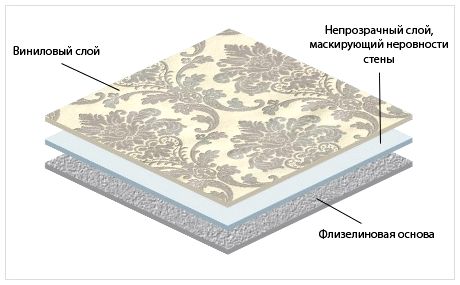 Composition of vinyl wallpaper.The advantage of vinyl flooring is its durability and resistance to external influences. However, when applying glue, the canvas is significantly deformed, stretching. And when drying, it shrinks again. As a result, the seams may come apart. This material does not allow air to pass through, and when burning, it releases toxic substances. If air or glue bubbles form under the canvas, it is necessary to squeeze this formation to the seam with a roller or by hand. Wallpaper can be moved, re-glued within a few minutes after gluing. Vinyl wallpaper is moisture-resistant, so it can be used in rooms with high humidity or where the walls are regularly washed. But they do not tolerate temperature or humidity changes well. These wallpapers have the largest number of interesting decorative options. Return to contents</a>Non-woven wallpaper:Features In essence, this type is related to vinyl wallpaper, but has non-woven fabric as a base. They are very easy to glue. The glue is applied directly to the wall, then the canvas is pressed. They do not shrink after drying, so they are glued end to end. Non-woven fabric itself is an environmentally friendly material. It can be used independently - without a top vinyl coating. But together with vinyl, the environmental friendliness disappears. They are also often used for painting. Return to contents</a>Textile wallpaper: features
Composition of vinyl wallpaper.The advantage of vinyl flooring is its durability and resistance to external influences. However, when applying glue, the canvas is significantly deformed, stretching. And when drying, it shrinks again. As a result, the seams may come apart. This material does not allow air to pass through, and when burning, it releases toxic substances. If air or glue bubbles form under the canvas, it is necessary to squeeze this formation to the seam with a roller or by hand. Wallpaper can be moved, re-glued within a few minutes after gluing. Vinyl wallpaper is moisture-resistant, so it can be used in rooms with high humidity or where the walls are regularly washed. But they do not tolerate temperature or humidity changes well. These wallpapers have the largest number of interesting decorative options. Return to contents</a>Non-woven wallpaper:Features In essence, this type is related to vinyl wallpaper, but has non-woven fabric as a base. They are very easy to glue. The glue is applied directly to the wall, then the canvas is pressed. They do not shrink after drying, so they are glued end to end. Non-woven fabric itself is an environmentally friendly material. It can be used independently - without a top vinyl coating. But together with vinyl, the environmental friendliness disappears. They are also often used for painting. Return to contents</a>Textile wallpaper: features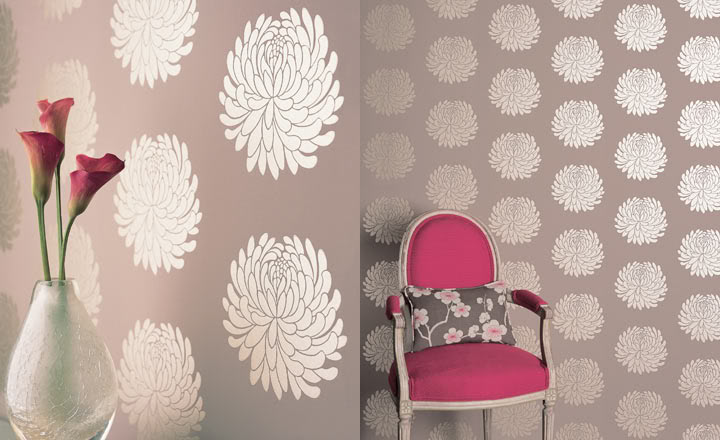 Textile wallpaper has an unusual texture,due to which they give the interior coziness, beauty and comfort. They are a canvas consisting of several layers: the base is paper, non-woven fabric, the front side is fabric or fibers. Their cost directly depends on the material of the top coat. Such wallpaper can be of different widths. It is even possible to wallpaper a room with a whole canvas (therefore, there will be only one seam). Such wallpaper is environmentally friendly, has good heat and sound insulation. They are resistant to sunlight, do not burn well. Flax fibers in the top coat give the canvas bactericidal properties. Textile wallpaper has the following varieties: on a synthetic basis (foam rubber), jute, silk, linen, velor, felt. Return to the table of contents</a>Glass wallpaper: features This type of finishing has been used abroad for over 50 years. In Russia, such wallpaper is still a novelty. Glass wallpaper is used mainly for office premises.
Textile wallpaper has an unusual texture,due to which they give the interior coziness, beauty and comfort. They are a canvas consisting of several layers: the base is paper, non-woven fabric, the front side is fabric or fibers. Their cost directly depends on the material of the top coat. Such wallpaper can be of different widths. It is even possible to wallpaper a room with a whole canvas (therefore, there will be only one seam). Such wallpaper is environmentally friendly, has good heat and sound insulation. They are resistant to sunlight, do not burn well. Flax fibers in the top coat give the canvas bactericidal properties. Textile wallpaper has the following varieties: on a synthetic basis (foam rubber), jute, silk, linen, velor, felt. Return to the table of contents</a>Glass wallpaper: features This type of finishing has been used abroad for over 50 years. In Russia, such wallpaper is still a novelty. Glass wallpaper is used mainly for office premises.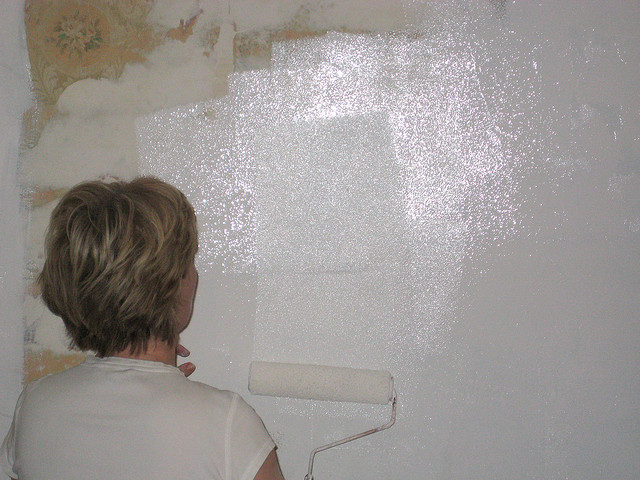 Glass fiber wallpaper is resistant to temperature changes, andalso have good water resistance. The technology of their production is as follows: from environmentally friendly materials (quartz sand, soda, limestone, dolomite) thin fibers are created, from which glass wallpaper is then woven on special machines. To keep the product in shape, it is treated with starch. Glass wallpaper has many advantages. They do not represent a fertile environment for fungi and bacteria. They do not electrify, do not emit toxic substances, are not an allergen. They do not burn well, are vapor permeable, waterproof, resistant to alkalis and acids. They can hide small cracks in the wall, gaps between panels. Return to contents</a>Other types of wallpaper material Besidesthe options considered, there are other types of finishing. These are liquid, cork, carpet, metal, leather, wood veneer, serpyanka, photo wallpaper. Return to contents</a>
Glass fiber wallpaper is resistant to temperature changes, andalso have good water resistance. The technology of their production is as follows: from environmentally friendly materials (quartz sand, soda, limestone, dolomite) thin fibers are created, from which glass wallpaper is then woven on special machines. To keep the product in shape, it is treated with starch. Glass wallpaper has many advantages. They do not represent a fertile environment for fungi and bacteria. They do not electrify, do not emit toxic substances, are not an allergen. They do not burn well, are vapor permeable, waterproof, resistant to alkalis and acids. They can hide small cracks in the wall, gaps between panels. Return to contents</a>Other types of wallpaper material Besidesthe options considered, there are other types of finishing. These are liquid, cork, carpet, metal, leather, wood veneer, serpyanka, photo wallpaper. Return to contents</a>
Which wallpaper to choose: the purpose of the room and the color
Sometimes, despite our choice, the premisesrequires a completely different type of covering. Let's consider several options. For children's rooms and bedrooms, environmentally friendly materials are definitely needed in the wallpaper. Therefore, paper, textile, natural (jute, cork) canvases should be used here. The bathroom and kitchen should be covered with moisture-resistant wallpaper. Vinyl, non-woven, glass wallpaper are suitable. In places of greatest traffic, it is necessary to glue wallpaper that is resistant to abrasion. Naturalness and environmental friendliness of materials are always a priority, but often such wallpaper is either fragile or expensive. Today, the most common (along with paper) are vinyl wallpaper. The choice of wallpaper depends not only on the functions of the room, but also on its shape and size. What wallpaper to choose if you want to visually change the room? Design rules come to the rescue. If the room needs to be made spacious, then it is preferable to use light shades of wallpaper. If the room is too spacious and uncomfortable, then choose dark tones. When the room is located on the south side, a cold color can be used in the decoration. In a northern room, cold shades will look gloomy, so warm colors are recommended for harmony. The presence/absence of a pattern and its size are important. Plain wallpaper emphasizes the geometry of the room (advantageous in rooms with a non-standard layout). A large pattern makes the room smaller, visually "breaks" the outlines of the walls, but also helps to hide their unevenness. In this case, the pattern should be the only accent in the interior, otherwise it will create a feeling of overload. A small pattern makes the room larger. As you know, each color has a certain effect on the human psyche. Choose wallpaper by color.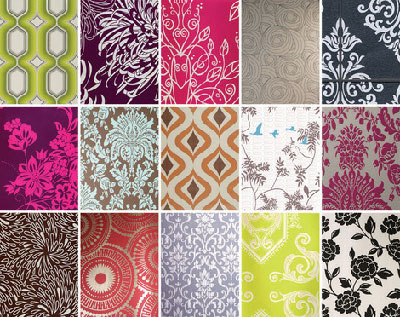 Color options for wallpaper.
Color options for wallpaper.
But one cannot be guided by general principlesmeanings of colors, because perception is individual. So, in order to , you need to be guided by a considerable list of rules. And in addition to wallpaper, there are other options for wall decoration (for example, painting). Before going to the store, you need to decide what exactly the room requires, and then be guided by your taste.


